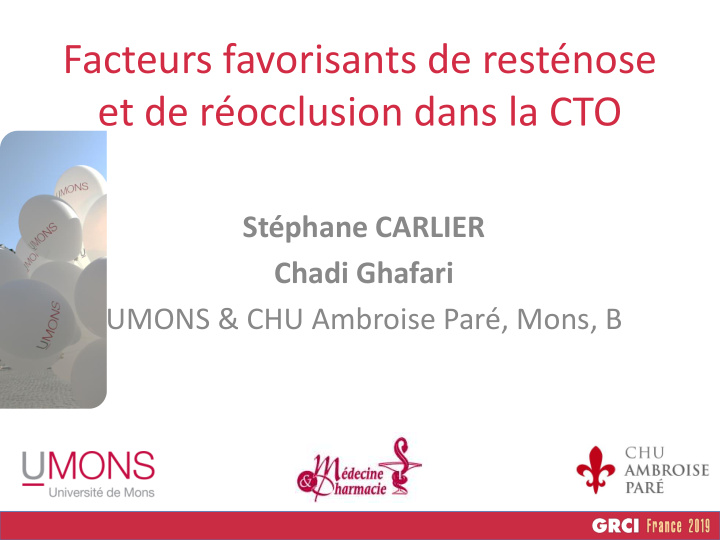



Facteurs favorisants de resténose et de réocclusion dans la CTO Stéphane CARLIER Chadi Ghafari UMONS & CHU Ambroise Paré, Mons, B
DÉCLARATION DE LIENS D'INTÉRÊT AVEC LA PRÉSENTATION Speaker's name : Stéphane CARLIER, Mons ☑ Consultant, Boston Scientific
Resténose post recanalisation CTO C’est regarder à une partie du problème de la RESTENOSE La RESTENOSE est un phénomène complexe – touche 5-10% DES – se présente en SCA: 30-60 %
Histopathology Inflammatory reaction post arterial injury persisting >90 d Risk Factors Patient characteristics Lesion types Procedural factors DM Mercado N et al Clinical and QCA predictors of coronary restenosis: J Am Coll Cardiol 2001; 38: 645 – 652
Histopathology Inflammatory reaction post arterial injury persisting >90 d Risk Factors Mechanisms Patient characteristics Biological Lesion types Arterial Procedural factors Stent factors DM Implantation factors
Biological mechanisms Resistance to antiproliferative drugs – Genetically or acquired Hypersensitivity reactions – To the polymer – To the metallic stent platform Inflammatory biomarkers and genetics – Role of MMP, PAI-1, C3a and C5a Arterial Mechanisms Wall shear stress Vessel remodeling / Glagov effect Late restenosis: chronic inflammation, neoatherosclerosis …
Stent Factor Raffaele Piccolo et al From BMS stent era… DES or BMS for PCI: systematic review and individual patient data meta-analysis. Lancet 2019; 393:2503 – 10 De Feyter PJ et al IVUS predictors for 6-mo QCA restenosis. Circulation 1999; 100:1777 – 1783 Network meta-nalysis BMS vs DES
Classification des resténoses R Mehran et al 1999 Diffuse Focal • BMS • DES The patterns of restenosis in SES and PES The predominant pattern of restenosis is a focal pattern of restenosis, although diffuse and proliferative restenosis are still seen with DES. *P- value calculated for the overall observed difference in the pattern of restenosis in PES and SES groups. SES indicates sirolimus- eluting stent; PES: paclitaxel- eluting stent; DES: drug-eluting stent. Reproduced with permission from Corbett et al
Minimal Stent Lumen Area Stent thrombosis (n=15) Matched controls (n=45) (mm 2 ) p<0.001 p<0.001 10 1 9 0,9 8 0,8 7 0,7 6 0,6 5 0,5 4 0,4 0,3 3 2 0,2 1 0,1 0 0 Minimum stent CSA Stent expansion J Am Coll Cardiol 2005;45 995-8
Significant residual stenosis in reference segments (%) p<0.001 Stent thrombosis (n=15) 100 Matched controls (n=45) 80 67 60 40 20 9 0 A significant residual reference segment stenosis was defined as a reference minimum lumen CSA <4mm 2 and a plaque burden >70% J Am Coll Cardiol 2005;45 995-8
Histopathology Inflammatory reaction post arterial injury persisting >90 d Risk Factors Mechanisms Patient characteristics Biological Lesion types Arterial Procedural factors Stent factors DM Implantation factors
Procedure Factor nonSTEMI → 1 DES in RCA… dans un autre hôpital
LL 18/12/1934 – F 84 y • Planned recath on 17/10/2019 for lesions Cx and LAD Early restenosis RCA, + FFR LAD → CABG
• PCI 20/10/2019: The RCA…
Megatron 3.5x16 16 atm OPN 3.5x15 30 atm
25
DA 18/09/1952 67 y preDM Male 4 Jun 2019 Unstable angina Tropo I: 1 (N<15) Stent LAD 2009 13 Jun Chest pain in rest and exercise since 2-3 weeks, ~2009
Sapph 2.75x18 14 atm Magmaris 3.5x25 16 atm NC 3.75x15 20 atm
13/6/2019 8/8/2019
8/8/2019
Resténose en fonction technique CTO
IVUS Guidance for CTO: evidence from RCT Clinical Impact of IVUS – Guided CTO Intervention with Zotarolimus- vs Biolimus-Eluting Stent (CTO-IVUS) Circ Cardiovasc Interv. 2015;8. DOI:10.1161/CIRCINTERVENTIONS.115.002592 Angiographic and clinical comparisons of IVUS-- versus angiography-guided DES implantation for CTO: two-year results from the randomised AIR-CTO study EuroIntervention 2015;10:1409-1417 33
Clinical evidence from RCT • Prospective RCT involving 8 experienced IVUS sites in China Randomized 1448 all comers, 2 nd gen DES • Zhang J. et al. TCT 2018 Late Breaking Clinical Trial J Am Coll Cardiol. 2018 Dec 18;72(24):3126-3137. doi: 10.1016/j.jacc.2018.09.013
Clinical evidence from Registries From 03/2003 through 12/2015, 6,005 patients undergoing PCI for complex lesions with drug-eluting stents were enrolled from a prospective institutional registry. All enrolled subjects had at least1 complex lesion (defined as bifurcation, chronic total occlusion, left main disease, long lesion, multivessel PCI, multiple stent implantation, in- stent restenosis, or heavily calcified lesion). 1,674 IVUS guided procedure vs 4,331 with only angiography DI MARIO Ki Hong et al. J Am Coll Cardiol. Volume 12, Issue 7, 8 April 2019, Pages 607-620
EuroIntervention 2018;14-online publish-ahead-of-print June 2018 Clinical use of intracoronary imaging. Part 1: guidance and optimization of coronary interventions. An expert consensus document of the European Association of Percutaneous Cardiovascular Interventions
A-t- on besoin d’IVUS pour les procédures de CTO? OUI! Pour diminuer les risques de resténose EuroIntervention 2018;14- An expert consensus
Recommend
More recommend